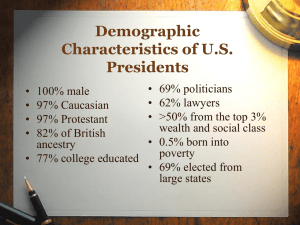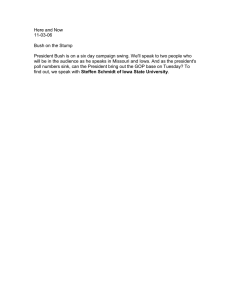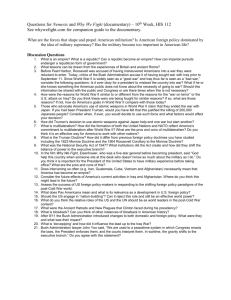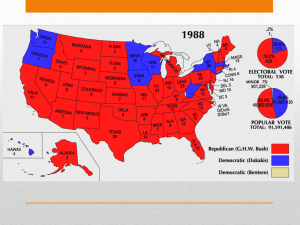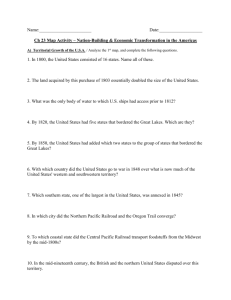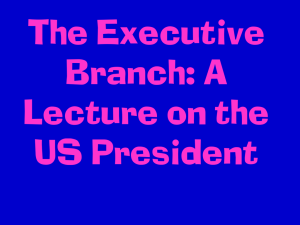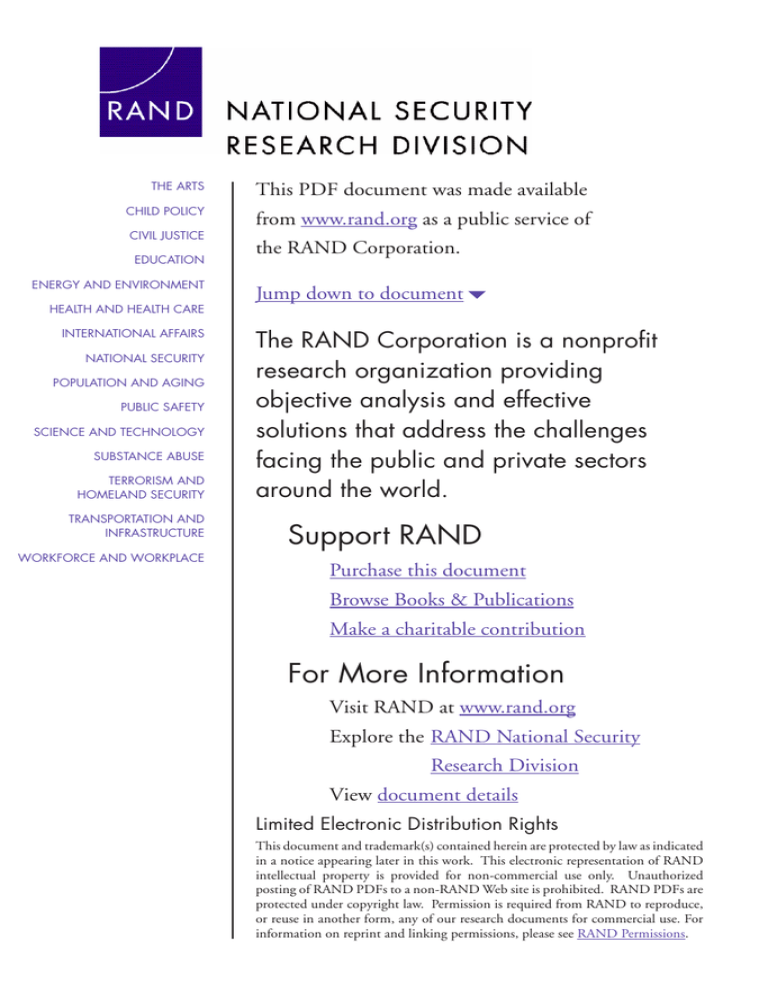
THE ARTS
This PDF document was made available
CHILD POLICY
from www.rand.org as a public service of
CIVIL JUSTICE
EDUCATION
ENERGY AND ENVIRONMENT
HEALTH AND HEALTH CARE
INTERNATIONAL AFFAIRS
NATIONAL SECURITY
POPULATION AND AGING
PUBLIC SAFETY
SCIENCE AND TECHNOLOGY
SUBSTANCE ABUSE
TERRORISM AND
HOMELAND SECURITY
TRANSPORTATION AND
INFRASTRUCTURE
WORKFORCE AND WORKPLACE
the RAND Corporation.
Jump down to document6
The RAND Corporation is a nonprofit
research organization providing
objective analysis and effective
solutions that address the challenges
facing the public and private sectors
around the world.
Support RAND
Purchase this document
Browse Books & Publications
Make a charitable contribution
For More Information
Visit RAND at www.rand.org
Explore theRAND National Security
Research Division
View document details
Limited Electronic Distribution Rights
This document and trademark(s) contained herein are protected by law as indicated
in a notice appearing later in this work. This electronic representation of RAND
intellectual property is provided for non-commercial use only. Unauthorized
posting of RAND PDFs to a non-RAND Web site is prohibited. RAND PDFs are
protected under copyright law. Permission is required from RAND to reproduce,
or reuse in another form, any of our research documents for commercial use. For
information on reprint and linking permissions, please see RAND Permissions.
This product is part of the RAND Corporation monograph series.
RAND monographs present major research findings that address the
challenges facing the public and private sectors. All RAND monographs undergo rigorous peer review to ensure high standards for
research quality and objectivity.
AFTER
THE
WAR
NATION-BUILDING FROM
FDR TO GEORGE W. BUSH
J AMES D OBBINS , M ICHELE A. P OOLE ,
A USTIN L ONG , B ENJAMIN R UNKLE
Prepared for the Carnegie Corporation of New York
NATIONAL SECURITY
RESEARCH DIVISION
The research described in this report was sponsored primarily by a grant
from the Carnegie Corporation of New York and was conducted under the
auspices of the International Security and Defense Policy Center within the
RAND National Security Research Division (NSRD). NSRD conducts
research and analysis for the Office of the Secretary of Defense, the Joint
Staff, the Unified Commands, the defense agencies, the Department of
the Navy, the Marine Corps, the U.S. Coast Guard, the U.S. Intelligence
Community, allied foreign governments, and foundations.
Library of Congress Cataloging-in-Publication Data
After the war : nation-building from FDR to George W. Bush / James Dobbins ... [et al.].
p. cm.
Includes bibliographical references.
ISBN 978-0-8330-4181-4 (pbk. : alk. paper)
1. United States—Foreign relations—1945–1989—Case studies. 2. United States—
Foreign relations—1989–—Case studies. 3. United States—Military policy—Case
studies. 4. Nation-building—Case studies. 5. Intervention (International law)—Case
studies. 6. Democratization—Case studies. I. Dobbins, James, 1942–
E840.A5895 2008
973.92—dc22
2008019408
Cover photo credits (clockwise from top left): Soviet Union Premier Josef Stalin, U.S. President
Franklin D. Roosevelt (center), and British Prime Minister Winston Churchill sit at the Teheran
Conference in the capital of Persia, Iran, on November 28, 1943 (AP Photo); President Harry S.
Truman riding through Berlin, Germany, July 1945, courtesy of the Harry S. Truman Library/
National Archives; U.S. President George W. Bush and Iraqi Prime Minister Nouri al-Maliki
speak to the press during their meeting in Baghdad, June 13, 2006 (AP Photo/Ahmad al-Rubaye);
U.S President Bill Clinton addresses students at the Treca High School in Sarajevo, which he visited
following the stability pact summit in the Bosnian capital, July 30, 1999 (AP Photo/Susan Walsh).
The RAND Corporation is a nonprofit research organization providing
objective analysis and effective solutions that address the challenges
facing the public and private sectors around the world. R AND’s
publications do not necessarily reflect the opinions of its research clients
and sponsors.
R® is a registered trademark.
Cover design by Carol Earnest
© Copyright 2008 RAND Corporation
All rights reserved. No part of this book may be reproduced in any
form by any electronic or mechanical means (including photocopying,
recording, or information storage and retrieval) without permission in
writing from RAND.
Published 2008 by the RAND Corporation
1776 Main Street, P.O. Box 2138, Santa Monica, CA 90407-2138
1200 South Hayes Street, Arlington, VA 22202-5050
4570 Fifth Avenue, Suite 600, Pittsburgh, PA 15213-2665
RAND URL: http://www.rand.org
To order RAND documents or to obtain additional information, contact
Distribution Services: Telephone: (310) 451-7002;
Fax: (310) 451-6915; Email: order@rand.org
Summary
Winning wars and securing the peace are preeminent responsibilities
of the U.S. defense and foreign-policy apparatus. In recent decades,
the United States’ overwhelming military superiority has allowed it to
“overawe” or overrun adversaries with comparative ease. Consolidating
victory and preventing a renewal of conflict has, by contrast, usually
taken more time, energy, and resources than originally foreseen. Few
recent efforts of this sort can be regarded as unqualified successes, and
one or two must be considered clear failures.
In previous RAND research, we have explored the various factors
that contribute to the success or failure of such missions. First among
these is the nature of the society being reformed and of the conflict
being terminated. Also important are the quality and quantity of the
military and civil assets being brought to bear by external actors. And
finally, there is the wisdom and skill with which these resources are
applied.
This volume looks at the last of these influences. It examines, in
particular, the manner in which U.S. policy toward postconflict reconstruction has been created and implemented and the effect that these
processes have had on mission outcomes. We start with a review of the
post–World War II occupations of Germany and Japan. The end of
the Cold War brought a second spate of such missions—in Somalia,
Haiti, Bosnia, and Kosovo. In the current decade, the terrorist attacks of
September 11, 2001, have given rise to ongoing operations in Afghanistan and Iraq.
Presidential personality obviously influences the U.S. government’s decisionmaking process in terms of approaches to and the con-
xi
xii
After the War: Nation-Building from FDR to George W. Bush
duct of reconstruction efforts: Each president will have specific preferences for oral or written interactions, different appetites for detail,
and varying tolerance for conflict among and with subordinates. In
examining the eight cases addressed here, which cover three historical
periods, we consider the personal styles of five U.S. presidents, the processes by which they made decisions, and the structures through which
these were given effect. The resultant approaches to decisionmaking
are categorized by reference to certain archetypal modes, including
the formalistic, the competitive, and the collegial. The first approach,
often associated with Dwight D. Eisenhower, emphasizes order and
hierarchy. The second, epitomized by Franklin Delano Roosevelt, seeks
wisdom through the clash of ideas among competing subordinates. The
third, identified with George H. W. Bush, encourages greater cooperation among presidential advisers. As these examples suggest, all three
models can yield excellent results. They can also, as will become evident, produce quite unsatisfactory outcomes. This monograph examines successful and unsuccessful approaches to decisionmaking in the
field of nation-building, with a view to identifying those combinations
of style, process, and structure that seem to have worked best.
Post–World War II Nation-Building
The occupations of Germany and Japan were planned under Franklin D. Roosevelt and executed under Harry Truman. It is difficult to
imagine two more different personalities: the first a worldly aristocrat, debonair, secretive, and informal, and the second a Midwestern
machine politician prepared to delegate but ready to take responsibility. Roosevelt was the last U.S. president to function without a formal
structure for the conduct of national security policy. Truman introduced the system under which the U.S. government operates today.
Despite these differences, there was a great deal of continuity
between the two administrations. Truman kept many of Roosevelt’s
cabinet and subcabinet officials. He was also able to draw on a number
of highly talented military and former military leaders who had matured
in command of the United States’ immense war effort, such as Douglas
Summary
xiii
MacArthur, Dwight D. Eisenhower, and George Marshall. Truman
also inherited and worked within the intellectual framework set by
his predecessor, putting his own stamp on U.S. policy only gradually,
over time. Roosevelt integrated military and diplomatic considerations
in his mind in a more informal manner. Truman established formal
structures to bring together the military and civil aspects of his administration. Both listened to conflicting advice and tried to ensure that all
relevant actors were heard from before making significant decisions.
The German and Japanese occupations remain the gold standard
for postwar reconstruction. No subsequent nation-building effort has
achieved comparable success. There are a number of reasons for this.
Both Germany and Japan were highly homogeneous societies (in the
German case, as a result of Nazi genocide and the enormous population transfers that occurred at the close of World War II). Both were
industrialized economies. Both had been devastatingly defeated, and
both had surrendered unconditionally. Few of these conditions were
replicated in future cases.
The scale of U.S. power was also greater in 1945 than at any time
before or since. At war’s end, 1.7 million U.S. soldiers were garrisoned
in the American sector of Germany, in which there were only 17 million Germans—a ratio of one foreign soldier to every 10 inhabitants.
At that point, the United States was producing and consuming half
the entire world’s annual product. It was also the world’s only nuclear
power, having just dropped two such weapons on Japanese cities.
If the German and Japanese occupations were alike in outcome,
they were very different in execution. In Japan, the strategy was one of
co-option, with nearly all elements of the Japanese government retained
and reformed from within. In Germany, the approach was exactly the
opposite. Every national institution was abolished and rebuilt anew
several years later. The former approach proved simpler and faster; the
latter was ultimately more thorough.
In both cases, U.S. occupation policy was extensively planned
and skillfully executed. Roosevelt had been reluctant to make decisions about postwar policy as long as the fighting continued, but extensive, if not fully coordinated, preparations had nevertheless been made
with the involvement of the U.S. Department of State (DOS) and the
xiv
After the War: Nation-Building from FDR to George W. Bush
U.S. Department of the Treasury, as well as the military services. With
9 million troops under arms and a defense budget approaching 40 percent of gross domestic product, the United States also had a very capable instrument with which to carry out its intentions. Those intentions
changed substantially in response to a changing international climate
as the occupations continued. Nevertheless, the original plans and
their implementing structures proved flexible enough to accommodate
these changes successfully, and the new system established by Truman
for the integration of the civil and military aspects of national security
policy provided necessary guidance.
Roosevelt had been president for nearly 10 years when the war
began and the nation’s responsibilities vastly expanded. His approach
to administration relied on a combination of intuition and experience,
allowing him to govern effectively through a very informal, conflictual,
and personalized approach. In contrast, the Truman administration
took a more structured approach. Accordingly, Truman created the
system embodied in the National Security Act of 1947 that remains in
effect today.1
Post–Cold War Nation-Building
Throughout the Cold War, most U.S. military interventions involved
either “hot” wars, such as those in Korea and Vietnam, or relatively brief
incursions, such as those in the Dominican Republic, Lebanon, Grenada, and Panama. Many international disputes were left unresolved,
lest their resolution upset the East-West balance. Berlin, Germany,
Europe, Cyprus, Palestine, Korea, and China all remained divided,
and either U.S. or United Nations (UN) forces policed and maintained
those divisions. The goal of such interventions was not nation-building
but the policing of cease-fires and the suppression of renewed conflict.
With the end of the Cold War, it became possible to secure broad
international support for and participation in efforts to end festering
conflicts and impose enduring peace. Nation-building, after a 40-year
1
See Public Law 80-235, National Security Act of 1947, July 26, 1947.
Summary
xv
hiatus, came back into vogue. The UN embarked on a number of such
missions in the 1990s, and the United States led four. The first began
under George H. W. Bush; the next three were conducted under the
William Jefferson Clinton administration.
The elder Bush and Clinton were also a study in contrasts. Bush
had a slightly stiff patrician style and a seemingly unbeatable resume,
having served in Congress, as head of the Central Intelligence Agency
(CIA), as ambassador to China, and as Ronald Reagan’s vice president. His decisionmaking style was formal, collegial, and methodical.
Clinton was an outgoing populist with no federal and scant international experience. He initially favored a highly unstructured and informal style of decisionmaking but adopted an increasingly staff-driven
approach after early embarrassing setbacks revealed the inadequacies
of his initial approach to governance.
Unlike Truman, Clinton did not profit from his predecessor’s
accumulated expertise. Coming as he did from a different party, one
that had been out of executive office for 12 years, Clinton filled his staff
and his cabinet with new faces, few of them with substantial executivebranch experience.
The elder Bush had proved himself a master statesman in dealing
with the twilight of a world familiar to him, the Cold War era. He and
his team proved less adept at dealing with the challenges of the new
world order, or disorder, that replaced the old. Under Bush’s leadership,
the United States helped reunify Germany, liberate Eastern Europe,
and deal with the disintegration of the Soviet Union. It also stood
aside as Yugoslavia descended into civil war. Responding to mounting
famine in Somali, Bush mounted a humanitarian rescue mission there
that, while successful in its own terms, contained none of the elements
that might have helped secure an enduring peace.
Clinton’s initial inclination was to act as his own chief of staff,
both dipping into the details and exploring broad lines of policy, satisfying his wide-ranging curiosity and exercising his formidable ability
to establish personal contacts. These energies were initially focused on
domestic policy, with the status of homosexuals in the military being
his first, poorly chosen foray into national security policy. The U.S.
military effort in Somalia remained on autopilot, steered by junior offi-
xvi
After the War: Nation-Building from FDR to George W. Bush
cials while their superiors oriented themselves to new jobs and an unfamiliar international environment.
Under Bush, the United States had sent a relatively large and
capable force to Somalia to execute a very limited mission: protecting the delivery of food and medicine to a starving population. Under
Clinton, the United States reduced that military presence from 20,000
to 2,000 soldiers and gave this residual force the mission of supporting
a UN-led program of grassroots democratization that was bound to
antagonize Somali warlords. This mismatch of soaring objectives and
plummeting capabilities caught up to the ill-fated mission in a firefight
in downtown Mogadishu, memorialized in the book and movie Blackhawk Down. Shortly thereafter, Clinton announced that he would
withdraw all U.S. forces within six months. A year later, the rest of the
UN troops left as well, having achieved nothing of lasting value.
This and other early missteps led Clinton to replace both his chief
of staff and his secretary of defense. The rest of his national security
team became much more cautious and methodical in planning subsequent military expeditions, recognizing that they could lose their
jobs and their reputations through inattention or ill-considered action.
Clinton himself never gave up his fascination with the details of policy
nor his penchant for personal engagement, but he did rely much more
heavily on White House staff to run a disciplined interagency process, conduct methodical planning, and generate carefully considered
options for his review.
As a result, the design and execution of nation-building missions improved. The Haiti intervention in 1994 was entirely successful
within the limited parameters that had been set for it—restore a freely
elected president to office, oversee elections to choose his successor,
and then leave. Unfortunately, this was too narrow a mission with too
limited a time span to repair a society as profoundly broken as Haiti’s.
The United States achieved all its stated objectives, left after two years,
and had to intervene again a decade later.
In 1995, after sending U.S. forces into Bosnia, Clinton again
pledged an early departure, but by 1996, he had learned enough to
renege on the promise. This intervention was the result of a long and
painful process of transatlantic and East-West consultations, the very
Summary
xvii
nature of which compelled a considerable degree of planning and forethought. Although the resultant stabilization strategy had to be modified over subsequent years, this lengthy process of gestation helped
ensure that those responsible for executing the mission had the personnel, money, and broad international backing necessary to do so
successfully.
Kosovo was the last and best prepared of the Clinton interventions. The air war lasted longer than intended but achieved its objectives without a single allied casualty. Serb forces abandoned Kosovo,
and North Atlantic Treaty Organization (NATO) troops came in
behind them. Security was quickly established, and the UN set up a
provisional administration. Within a few weeks, nearly all of the more
than 1 million Muslim refugees and displaced persons returned to their
homes, and a much smaller number of ethnic Serbs departed.
Clinton’s improving performance in the field of nation-building
had much to do with the increasingly methodical process by which
these missions were planned. Clinton himself retained ultimate authority and never gave the final go-ahead until convinced that no option
short of the dispatch of U.S. troops would suffice. This uncertainty
over the President’s ultimate willingness to launch an operation was a
source of considerable frustration to those urging military action. The
effect, however, was to allow for an extended debate between the advocates of such action, usually in DOS, and opponents, usually in the
U.S. Department of Defense (DoD), regarding the wisdom and shape
of these operations. As a result, every downside to intervention that its
opponents could conceive was considered, every alternative they could
offer was explored, and every assumption they questioned was subjected to examination.
Clinton was also successful in leveraging relatively modest U.S.
troop and financial commitments to secure much larger international
engagements. The United States provided less than a quarter of NATO
forces in Bosnia and less than a sixth of those in Kosovo. Its financial contribution to the two operations was commensurately low. No
one doubted that these were U.S.-led interventions—ones that would
not have taken place absent Washington’s leadership—but they were
also heavily multinational in character, with NATO, the UN, the
xviii
After the War: Nation-Building from FDR to George W. Bush
Organization for Security and Co-Operation in Europe (OSCE), the
World Bank, and other international organizations playing major roles.
The result was enhanced legitimacy and lowered cost, achieved at the
expense of some sharing of authority and responsibility.
Neither of the Balkan interventions brought about transformations of the sort made in post–World War II Germany and Japan.
Christians and Muslims, Serbs and Croats remained mutually suspicious. Politics continued to be organized along ethnic lines. But politics,
not armed conflict, became the field in which competition for wealth
and power was played out, and this pacification was, fundamentally,
what the interventions had sought to achieve. Bosnia and Kosovo are
not yet self-sustained polities, but U.S. troops are entirely out of the
former, and only a few hundred remain in the latter, and both societies
are headed toward eventual membership in the European Union
Clinton’s opponents in Congress spent much of the 1990s criticizing both the conduct and the fact of his nation-building activity.
Some of this criticism was ill informed—that these deployments were
harming readiness, enlistment, and retention, for instance—but the
overall effect was not entirely unconstructive. Faced with a skeptical
Congress, the administration needed to constantly demonstrate that its
efforts were enhancing security and promoting political and economic
reform in these societies. Such claims were critically scrutinized and
sometimes shown to be exaggerated. Thus, the administration was kept
constantly on its toes.
A more pernicious effect of this criticism was to discourage efforts
to institutionalize the conduct of such missions. Many in the U.S.
defense establishment saw nation-building as a diversion from what
they believed to be their real purpose, which was to fight and win
conventional wars, a view that was reinforced by their congressional
overseers. Accordingly, there was little effort to develop a coherent doctrine for the conduct of such operations or to build a cadre of experts
who would be available from one mission to the next. DOS also tended
to treat each successive mission as an exceptional, not-to-be-repeated
demand on its resources. Only the White House restructured itself to
take on these new tasks, and these changes proved transient. A directorate was created within the National Security Council to handle the
Summary
xix
planning and coordination of what were called, somewhat euphemistically, complex contingency operations, nation-building having become
a term of opprobrium. In 1997, Clinton issued Presidential Decision
Directive (PDD) 56, which established an interagency structure and
mandated a set of procedures for the future planning and conduct of
such operations.2
Post-9/11 Nation-Building
George W. Bush retained Clinton’s interagency machinery largely
intact, though, naturally, he replaced most of the senior players. He
entirely dismantled the prior administration’s nation-building component, however. A directive that would have replaced and, indeed,
extended and improved on PDD 56 was drafted by the new National
Security Council staff but quashed by the Pentagon. The failure of
Condoleezza Rice, the new National Security Advisor, to persist in getting the directive issued may have reflected an expectation that no new
nation-building would be initiated on her watch, given the negative
attitude that she and Bush had expressed toward such activity during
the recent presidential campaign.
This attitude changed as a result of the September 11, 2001,
attacks on New York and Washington, but it did so only slowly. If
the Bush administration was to reconstruct, first, Afghanistan and,
then, Iraq, it would do so with an eagerness to distinguish its conduct from that of the preceding administration. Whereas, following
the debacle of Somalia and the disappointing results in Haiti, Clinton
had abandoned quick exit strategies, embraced the Powell doctrine of
overwhelming force, sought the broadest possible multilateral participation, and accepted the need for long-term commitment to societies
it was trying to reform and rebuild, George W. Bush remained wary
of long-term entanglements, emphasized economy of force, was skeptical of multilateral institutions, and envisaged an initially quite limited
role for the United States in rebuilding and reforming the countries it
occupied.
2
See Presidential Decision Directive 56, Managing Complex Contingency Operations,
May 1997.
xx
After the War: Nation-Building from FDR to George W. Bush
Secretary of Defense Donald Rumsfeld was most explicit in
explaining this new approach. In speeches and newspaper articles, he
argued that, by flooding Bosnia and Kosovo with troops and money,
the United States and its allies had turned both societies into permanent
wards of the international community. By limiting U.S. engagement in
Afghanistan and Iraq, in terms of military personnel, economic assistance, and duration, the Bush administration intended to ensure that
those two counties achieved self-sufficiency much more quickly.
In Afghanistan, this low-profile, small-footprint philosophy was
applied with considerable rigor, making this mission the least resourced
U.S.-led nation-building operations in modern history. On a per capita
basis, Bosnia, for instance, had received 50 times more international
military personnel and 16 times more economic assistance than did
Afghanistan over the first couple of years of reconstruction. In Afghanistan, the administration refused to use U.S. troops for peacekeeping
and opposed the deployment of international forces outside the capital for the same purpose. Security was to remain a responsibility of
the Afghans, despite the fact that the country had neither army nor
police forces. Not surprisingly, Afghanistan became more—not less—
dependent on external assistance as the years went by.
Nation-building in Iraq was more heavily resourced than in
Afghanistan, but, otherwise, the break with past practice was even
more radical. Only weeks before the invasion, President Bush transferred responsibility for overseeing all the nonmilitary aspects of the
occupation from DOS to DoD. For the first time in more than 50
years, there would be no U.S. diplomatic mission working alongside
U.S. forces in a postconflict environment. Rejecting the division of
labor developed in Korea, Vietnam, the Dominican Republic, Lebanon, Grenada, Panama, Somalia, Haiti, Bosnia, Kosovo, and Afghanistan, the administration chose to revert to an organizational model
similar to that last employed in Germany and Japan 50 years earlier.
DoD, not DOS, would oversee both democratization and economic
development, including agricultural reform, the resumption of oil
exports, the creation of a new currency, the setting of tariffs, the creation of a free media, the promotion of civil society, the establishment of
political parties, the drafting of a constitution, and the organiza-
Summary
xxi
tion of elections—all activities with which DoD had little modern
experience.
The reasons for this decision seemed persuasive at the time: Bush
had become frustrated with the slow pace of reconstruction in Afghanistan, a failure that he attributed to poor interagency coordination rather
than to a paucity of resources. There was also a sense that civil-military
wrangling had interfered with implementation of the Dayton accord in
Bosnia in the mid-1990s. Perhaps also sensing that DOS had reservations about the wisdom of invading Iraq, Bush decided to put all aspects
of the operation under DoD, thereby ensuring unity of command and
unreserved commitment to the mission. However, DoD proved poorly
equipped to assume the new responsibilities thrust upon it. The Coalition Provisional Authority (CPA), established under DoD auspices to
govern Iraq, was never close to fully staffed, and most of those working in it remained for only a few months. Many of CPA administrator
Paul Bremer’s most senior advisers came from other agencies, but there
were never enough, and the expertise below this level dropped sharply.
What institutional memory the U.S. government retained in the field
of nation-building thus remained largely untapped. The result was a
long series of unforeseen challenges and hastily improvised responses.
Most of the early decisions that shaped the Afghanistan and Iraq
operations were eventually reversed, but only after the operations conclusively failed to achieve their objectives. Beginning in late 2003, personnel and financial commitments to Afghanistan were doubled and
redoubled, then redoubled again, only to barely keep pace with the
mounting threat of a resurgent Taliban. In Iraq, civil tasks were returned
to DOS, and a diplomatic mission was opened in 2004. Civilian staffing remained a problem, but never to the extent that had plagued the
CPA. Troop levels were raised, more sophisticated counterinsurgency
tactics were introduced, and a dialogue was initiated with neighboring
governments, including Iran. By the end of 2007, the security situation
had begun to improve, though the possibility of an even wider civil war
loomed, with both Sunni and Shia better organized and more heavily
armed than they had been a year earlier.
In the immediate aftermath of 9/11, the Bush administration’s
decisionmaking processes worked well. Indeed, despite the necessary
xxii
After the War: Nation-Building from FDR to George W. Bush
lack of any forward planning, the Afghan campaign of 2001 provided
a textbook illustration of the successful integration of force and diplomacy in terms of national power and international legitimacy. Every
U.S. government agency involved worked toward a common goal with
minimal friction. The CIA ran paramilitary operations, DoD ran the
military, and DOS oversaw the diplomacy. Each deferred to the others
in their spheres of competence. The CIA put together an overall strategy for the war and guided the application of U.S. military power in
support of local anti-Taliban insurgents. That agency also put U.S. diplomats in contact with key Afghan actors. The devastating effect of
U.S. air power gave decisive weight to U.S. diplomacy. Nearly universal
international support gave that diplomacy added influence. As a result,
operating from a standing start, the United States was able to both
displace the Taliban and replace it with a representative, moderate,
domestically popular, and internationally recognized regime within a
matter of weeks.
The absence of an existing structure or agreed-upon doctrine for
the conduct of postconflict reconstruction was not immediately felt.
There was not time for elaborate planning, and the administration had,
in any case, no intention of engaging in large-scale nation-building.
Once it found itself embroiled in such an enterprise, however, its lack
of plans and the absence of any consensus on how to proceed became
more debilitating. Each agency blamed the other for the lack of progress, with DOS arguing that there could be no development without
security, DoD making the opposite case, and the President becoming increasingly frustrated. One response might have been for him to
empower the White House staff to play a more forceful role in setting
and ensuring the implementation of reconstruction policy. Instead,
with war in Iraq looming, he turned over responsibility for coordinating the interagency effort to DoD.
In doing so, he effectively took himself and his staff out of the
loop. Policies were set and direction given by the Secretary of Defense
and his staff or at the initiative of the CPA administrator in Iraq. For
half a year, there was no structured debate among cabinet-level officers
on Iraq policy, nor were contentious issues put to the President for resolution. Indeed, for the first few months, reports from Iraq were not even
Summary
xxiii
shared with other agencies or the White House. Decisions that would
to fundamentally shape the occupation, including the disbandment
of the army, the exclusion tens of thousands of former regime officials
from office, and the timetable for elections were made and announced
without formal interagency review. It was not until late 2003 that the
White House staff resumed its role of running the interagency process,
overseeing presidential decisionmaking, and coordinating the relevant
agencies to ensure their implementation.
Presidential style had much do with the resultant process. George
W. Bush practiced a top-down, inspirational mode of leadership that
did not invite dissent or welcome extensive debate. He preferred to
maximize control, minimize leaks, and maintain message discipline
at the expense of the sort of give and take among his chief advisers
that might have yielded more informed choices and better considered
decisions. The result was unprecedented public support for the initial
military campaigns in both Afghanistan and Iraq but poor planning
and inept implementation of the postconflict strategy. Blame for these
lapses has sometimes been attributed to Condoleezza Rice, the President’s young, and, in comparison with her Cabinet-level colleagues,
less experienced, National Security Advisor. It seems likely, however,
that President Bush received the interagency process that he wanted.
His failure, for instance, to solicit the views of the Secretary of Defense,
the Secretary of State, or the Director of the CIA before deciding to
invade Iraq was almost certainly a calculated choice on his part, not
an oversight on the part of his staff, as was the decision to transfer to
the Secretary of Defense the responsibility for integrating other agency
efforts and views during the occupation of Iraq. Both choices would
seem to reflect a low tolerance for discord among subordinates and
a limited appetite for mastering the level of detail that would have
allowed him to effectively adjudicate disputes among them.
In early 2007, President Bush acted contrary to the initial recommendations of many of his senior civilian and military advisers to significantly increase U.S. troop strength in Iraq. In this instance, Bush
does seem to have consulted widely within and outside the National
Security Council, giving all major stakeholders an opportunity to
express their views. Whether this more comprehensive and methodi-
xxiv
After the War: Nation-Building from FDR to George W. Bush
cal process of consultation was the result of experience or simply the
product of his weakened political position is unclear. In any case,
the decision to surge troop levels in Iraq, in conjunction with other
factors, did result in a significant reduction of violence there. This
experience suggests that, while a president need not adhere to advisers’
recommendations, the result of seeking such advice may be better decisions and a more wholehearted implementation.
Conclusions
Successful nation-building requires unity of effort across multiple agencies and, often, multiple governments. Decisionmaking structures thus
need to provide for a combination of common effort and unified direction. The entire national security establishment needs to be engaged.
This is not a responsibility that presidents can afford to delegate, nor is
it one that any single department of government can handle. Indeed,
the requirement to include not just other agencies but also other governments and international organizations in modern nation-building
enterprises makes any replication of the post–World War II viceroy
model epitomized by Douglas MacArthur in Japan highly unrealistic.
Washington’s decisionmaking structures need to reflect an appropriate balance between a well-structured, deliberative process and the
varying styles of an individual president. The Clinton-era PDD 56 provides one possible template. However much it was followed during that
administration, the process as outlined therein at least gave guidance
to what “right” decisionmaking would look like, creating expectations
of orderly debate and thorough planning that were largely met as long
as it remained in force.
The key element of any decisionmaking process is structured
debate within one or more senior interagency groups that include all
relevant agencies. This will mean, at a minimum, the involvement of
DoD and DOS, along with the CIA (in an advisory rather than policymaking capacity, though the line between the two is seldom distinct).
These groups provide a forum for the airing of divergent views and
should be tasked with creating a range of options and likely scenarios.
Members should be allowed significant latitude to disagree in this ini-
Summary
xxv
tial period. In effect, this is an attempt to institutionalize the “collegial” model of decisionmaking.
Of particular importance is this model’s emphasis on lateral communication. Unfortunately, this can depend heavily on the personalities involved. Parochial tendencies often limit willingness and ability to
communicate. Steps to establish a certain level of interagency comfort
could facilitate such communication. One possible way to foster this
comfort would be to require cross- or interagency tours for those seeking senior positions within civilian agencies, much as the military services require a joint assignment for promotion.
Once the president chooses or endorses a particular option, a fully
integrated political-military plan should be generated. This is tricky,
because the same type of interagency group that was given free range
to debate and dissent must now be tasked with drafting and executing
a single plan that may be an alternative to which some were strenuously
opposed in the initial phase of decisionmaking. Regardless, it is important that all relevant players be included in implementation planning
and execution.
Civil-military integration means having civilian agencies give
advice on war plans and having the military comment on diplomacy.
This will undoubtedly be painful; the military doubtless does not want
to hear the U.S. Agency for International Development’s (USAID’s)
view on target selection any more than USAID wants to hear the military’s view on the utility of public-works projects in combat zones.
However, advice does not equal final authority; serious disputes will
have to be aired and resolved by senior leaders, including the president,
if necessary. It is better that such disputes be ironed out before nationbuilding begins rather than in its midst.
While integrated political-military planning is important, so is
establishing a clear and enduring division of labor for various aspects of
nation-building. It is a bureaucratic truism that “when all are responsible for an issue, none takes responsibility.” In other words, a lack of
clear responsibility is a recipe for buck-passing and indecision.
For the past 15 years, critical functions, such as overseeing military and police training, providing humanitarian and reconstruction aid, and promoting democratic development have been repeat-
xxvi
After the War: Nation-Building from FDR to George W. Bush
edly transferred from DOS to DoD and back again. This has left each
agency uncertain of its long-term responsibilities and, consequently,
disinclined to invest in improving its performance.
The United States thus needs to decide whether nation-building
is going to be an enduring part of its repertoire. If so, it will need to
rebalance the political and the military elements of national power. For
example, the Army and the Marine Corps are projected to add about
90,000 troops to their end strength over the next several years. Despite
recent and projected future expansion, the total number of personnel
in civilian agencies associated with nation-building, including USAID,
the CIA, and DOS, is dwarfed by this number. Budgets are similarly
weighted toward the military. Absent some effort to redress this imbalance and to create an operational civilian cadre for nation-building, the
implementation of U.S. policy in this field is likely to remain stunted
no matter how good the quality of its decisionmaking.
If DOS and USAID are to receive more funding and personnel
to perform these functions, those personnel will need to be available
when required. It is not realistic to think that domestic civil servants
can be sent involuntarily into a war zone. U.S. Foreign Service personnel, however, are already subject, in theory at least, to worldwide availability. This practice of directed assignments has largely lapsed since
thousands of DOS and USAID officers were sent to Vietnam. It will
have to be revitalized if these agencies are to secure and retain the
higher funding and personnel levels that their nation-building responsibilities require
Setbacks in Iraq and a sense that U.S. leadership is faltering worldwide have led some to argue that the entire interagency structure first
given form in 1947 is outdated. The world, it is argued, is a far more
complex place today, and the U.S. government is much larger. In fact,
however, the world is not more chaotic today than it was in 1947, and
the federal government is not all that much larger. One has only to
recall the incredible turbulence that affected the international system
in the decade after World War II, with the fall of the Iron Curtain, the
“loss” of China, and the disintegration of the British and French colonial empires, to put today’s challenges into perspective. It is true that
information moves much more quickly today, and the federal govern-
Summary
xxvii
ment has many more civilian employees and fewer military personnel
than it did 60 years ago. Neither of these factors necessarily makes
policy harder to formulate and execute.
In fact, the current system for integrating defense and foreign
policy has actually functioned quite well for most of the past 60 years.
It helped win the Cold War, unite Europe, cope with the collapse of
the Soviet Union, deal with the early challenges of the post–Cold War
era, and respond to the attacks of 9/11. A system that was working adequately only six years ago is probably not irretrievably broken today. As
this study illustrates, many of what are now considered flawed decisions
of the past several years were made not because the interagency system
was defective but, rather, because it was circumvented or neglected.
That said, there are improvements that would strengthen the
capacity of the current system to deal successfully with the intense
interagency and international integration required for successful
nation-building. Legislation to establish an enduring division of labor
among DOS, DoD, USAID, and other agencies engaged in these missions would promote the development of a more professional approach
to nation-building, as would a provision to require a tour of service in a
national security agency other than one’s own for entry into the senior
executive staff and foreign service. Legislation to set aside a certain
proportion of subcabinet and White House staff positions for career
officers would also help sustain the learning curve from one administration to the next.
Whatever approach to decisionmaking presidents may adopt—
formal, competitive, collegial, or some combination thereof—it is
important that they foster debate among their principal advisers and
value disciplined dissent as an essential aid to wise decisionmaking. It
is equally important that presidents and their principal advisers have
access to professional, experienced staff. Once decisions are made, these
need to be implemented, to the extent possible, through established
structures, employing tried methodologies and respecting existing
lines of authority. Most bureaucratic innovation comes at significant
cost in terms of immediately degraded performance, whatever its longterm effect. Institutional improvisation may be necessary to cope with
new challenges. Nation-building, however, is a familiar and repetitive
xxviii
After the War: Nation-Building from FDR to George W. Bush
requirement—one that requires greater consistency of method and
transmission of expertise from one administration to the next than the
system has so far achieved.
It should come as no surprise that administrations get better at
policy formulation and execution as they progress. Neither can it come
as a shock that much of this acquired experience is not passed from one
administration to the next, particularly when the successor is drawn
from the opposing party. Nevertheless, the degree to which the U.S.
government has experienced a regression of competence in the field of
nation-building from one administration the next should be a source
of real concern. Obstacles to the transmission of expertise thus need to
be identified and, where possible, leveled.
Two modern administrations are often held up as exemplars of
orderly process and sound policy under exceptionally challenging circumstances. Harry Truman set U.S. strategy for the conduct of the
Cold War, and George H. W. Bush brought it to a successful conclusion. Both had been vice president and had considerable experience in
Washington. Both succeeded presidents of their own party. Truman
took office at the opening of the Cold War, in the 13th year of a Democratic administration, and he retained, in one capacity or another, many
members of his predecessor’s national security team. Bush succeeded
Reagan, also a Republican. Neither Truman nor Bush had campaigned
against his predecessor’s record, and neither administration felt obligated to do things differently simply to disassociate itself from what
had come before. The quality of both presidencies profited greatly from
the resultant continuity of personnel and policy.
Clinton and George W. Bush, by contrast, had no Washington
experience, and both emphasized discontinuity with their predecessors. Many of their advisers felt even more strongly the need to do so.
Most of these advisers had Washington experience, but it was dated,
the world, in both cases, having changed dramatically while their parties were out of power. Clinton faltered immediately in Somalia. Bush
did well at first in Afghanistan but did not sustain that success in Iraq,
or, for that matter, in Afghanistan.
Frequent elections, the two-party system, and presidential term
limits are designed to produce benefits that transcend technical compe-
Summary
xxix
tence in the design and implementation of foreign policy. Alternation
in power is, in fact, an essential condition and necessary product of
democracy. The 22nd Amendment of the Constitution, which set term
limits for all future presidents and was passed in immediate aftermath
of President Roosevelt’s successful conduct of World War II, represents
a rather explicit national choice for innovation over expertise.
In the U.S. case, however, the costs and risks associated with
presidential transitions are magnified by the role of political patronage in staffing the national security establishment. The United States’
reliance on the “spoils” system to empty and fill thousands of highand medium-level policy positions every four, eight, or 12 years is
unmatched in the Western world. The effect is to ensure a high degree
of inexperience in the opening years of many presidencies, particularly
when the opposition party comes to power. This reliance on patronage
to fill key staff positions effectively insulates political leaders at the top
from professional advice at the bottom, imposing several layers of ideological buffer between the two. It thus promotes barriers to continuity
of policy from one administration to the next. It also results in diminished competence in a civil service whose members are denied access to
positions of greater responsibility. These problems have become more
acute in recent decades as the number of positions in the national security establishment subject to partisan selection has risen.
It is unrealistic to think that a country as large, varied, and
dynamic as the United States could be administered by a civil service
of elite mandarins on the basis of British, French, or German models.
Nevertheless, Congress has largely walled off the U.S. military, law
enforcement, and intelligence services from patronage appointments
on the grounds that public security is too important to be politicized.
Setting aside some proportion of subcabinet and White House staff
positions in the national security arena for career personnel could be
similarly justified and would go far to diminish the turbulence associated with changes in administrations, thereby reducing the alarming incidence of neophyte presidents making flawed decisions on the
advice of loyal but inadequately experienced staff.



